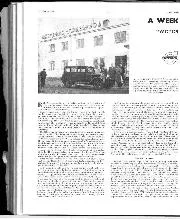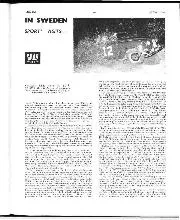

A week in Sweden
"Motor Sport" visits – Rally successes having put Volvo and Saab in the forefront of the sporting scene, these motor cars are now highly esteemed in Europe and America, so it seemed…
THE LUBRICATION OF HIGH EFFICIENCY ENGINES.
AS the term “high efficiency ” applies to most modern engines it is perhaps as well to point out that these notes refer mainly to such engines as may be used for road and track racing, hill climbing, reliability trials and general sports purposes. It is proposed to discuss the matter under these heads, since, with various tasks, different grades of oil can be used in the same engine to some advantage. Road and track racing make very similar demands upon a lubricant, except in the case of short runs comprising the usual Broold.ands meetings—practically all the work is done on full throttle, and the oil becomes extremely hot, it is therefore necessary to use a lubricant
which when heated still possesses a high lubricating value, and remains sufficiently tenacious or viscous to resist those forces tending to eject it from the engine (so setting up a high oil consumption) and to enable the oil pumps to maintain a reasonable efficiency. Castor oil was long ago found to possess these qualities and was adopted for use in many of the early air-cooled aviation engines, it was also known to resist the tendency of an air-cooled engine, overheated by much full throttle, to seize up and, in addition, was reported to remain fairly fluid at low temperatures.
These appear to be the reasons which brought about the use of castor oil as an engine lubricant, but the feeling is now growing among engineers that its general Use to-day in racing car engines may be due to custom rather than the lack of possible alternatives.
In addition to lubrication, an equally important duty imposed upon oil is that of cooling, and a very large quantity of heat which would otherwise cause serious trouble is removed from pistons and bearings by the oil. Thus, any racing machine should be designed to carry an adequate amount of properly cooled oil.
At present we have very few oils from which to make a selection for racing purposes, and probably nine-tenths of all racing machines are run on some form of castor or castor compounded oil, the remainder using some form of mineral distillate braced up with animal and vegetable fat.
In actual running these castor oils give very little trouble ; the after-effects, such as dirtiness, gumminess when cold, and carbon deposit, being the main objections to their use—these are very real objections too, and effectually preclude the use of the oil for touring purposes.
Dried or semi-burnt castor is extremely tenacious, and sparking plugs once oiled up on this lubricant can seldom be cleaned.
Unless an engine be used solely for racing and is constantly being stripped down, castor oil is best avoided.
Probably the limited amount of oil used by the racing fraternity does not justify the production of an alternative, especially as racing oils are seldom bought, but the general public might very well be impressed by an ordinary lubricant which was proved on the race track.
Therefore, for long distance racing, no particular advice can be given as to the selection of a lubricant, but attention is again directed to the necessity of carrying an adequate amount of oil and of providing means of cooling.
The bulk of the oil in a racing machine soon attains a temperature of 1200 F. and then rises to about 160° F., as a general rule. In aviation 1300 F. is regarded as the correct temperature to be maintained. Short track races and hill climbs present somewhat different conditions, for very slightly increased accelerations may mean everything and oil consumption is not a factor to be reckoned with, it is therefore permissible to use a thinner oil and thus add to the mechanical efficiency of the engine by reducing the friction
OH, TESTING MACHINE: LUBRICANTS ARE TESTED AT A PRESSURE OF 15,000 LBS. PER Sc. IN.
losses caused by using thick or sticky oils such as heavy castor compounds.
A thin, but extremely durable oil has been produced by one of the great oil companies, and is now on the market.
Experiments with this oil showed that Brooklands lap times might be improved by a second or more merely by changing to the thinner oil, and this confirmed increased power readings noted on the test bench. It was also shown this oil would stand up to its work at least as well as castor, this being proved by a success in a long road race. The only objection to the general use of such an oil for racing is that a ” sloppy ” engine or one with external oil leaks will suffer from a very high oil consumption—” consumption” perhaps being a misnomer, since ” waste ” would be a more accurate description.
For reliability trials and general sports purposes, either straight mineral or slightly compounded mineral oils are advisable, and here a very wide range is available from which a selection may be made.
The thin oil previously referred to comes in the slightly compounded category.
It is unfortunate that no definite classification of automobile lubricating oils exists, neither have we any concrete method of describing the qualities found or requisite in oils—thus beyond accepting the oil maker’s recommendations or making comparative running tests for himself, the engineer has little to guide him, and as in carrying out of running tests is an extremely difficult, lengthy, and expensive progress, the recommendation of the oil company is usually accepted.
Specifications of oils are, of course, used—these generally being confined to the physical characteristics of the oils and serving merely to identify them rather than to indicate their behaviour when used in an engine.
The main points of interest to be extracted from an oil specification are the figures indicating its thickness or viscosity over a temperature range of 700 F.2000 F., its cold test and the nature of the compounding agent or agents, if any.
The viscosity figures may serve to indicate how suitable the oil is in conjunction with the oil ways, method of oil distribution., oil-filters, type of pumps, and piston design, but no arbitrary judgment of the lubricating value of any oil must be made or based on its viscosity curve or even on its viscosity at any particular temperature.
Lubricating value is not to be measured by thickness, it has something to do with an elusive quality called “oiliness,” which no one has yet been able to measure or define. Various forms of oil testing machines exist, such as the Deeley and others, and they appear to show differences in oils and their ” oiliness ; but, unfortunately, these differences do not appear to show up in practice, and have even been known to be reversed, in fact one famous German machine shows ordinary Kerosene to be the best lubricant I
The cold test will naturally give us some idea of the suitability of the oil for winter use and will also serve as a warning against running the engine fast before the oil has warmed up and has had time to circulate.
The nature and amount of compounding agents will show whether much carbon may be expected, and in this connection one may remark that over several years work and after innumerable tests it has been found that practically every fat used in compounding mineral oils results in an increased carbon deposit. Differences in oil pressures will, of course, be noticed in using oils in different viscosities and at varying temperatures, no undue alarm need be felt if a lower oil pressure is registered with a thinner oil, the material point being to satisfy oneself that the pump is working properly, it stands to reason that less effort is required
to force the same amount of thinner oil through the same passages in the same time, and therefore to note a low pressure reading on the gauge.
If the same oil flow is maintained through the bearings, it matters little whether it flows at 5 lbs. or 25 lbs. pressure and it is a fallacy to suppose that a few pounds difference in oil pressure can have any material effect in supporting say a big end loading of 400-500 lbs. per square inch.
It is, of course, possible that some oil pimps are not so efficient with a thin oil as with a thicker one, but it is not difficult to check the delivery.
Furthermore, a thin oil can even show a higher pressure than a thick one in some systems, especially where the suction side of the pump does not deal efficiently with a heavy liquid.
During the last few years an enormous amount of research work has been done in connection with motorcar lubricants, most of this work being of a pioneer nature, but there are now signs of development, and it is hoped that ere long new methods of treating mineral oils, which of course form the bulk of all lubricants, will be in vogue and that we shall be independent of such fats as lard, rape, coco-nut, palm, root-grease, castor, whale, sperm, etc., which are now used to increase lubricating value.



